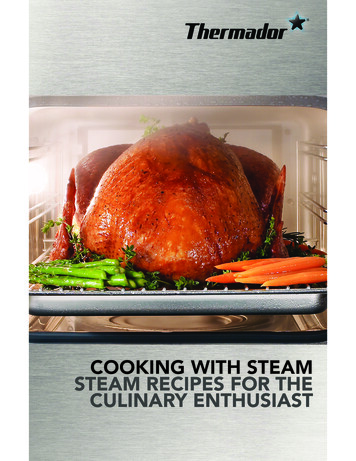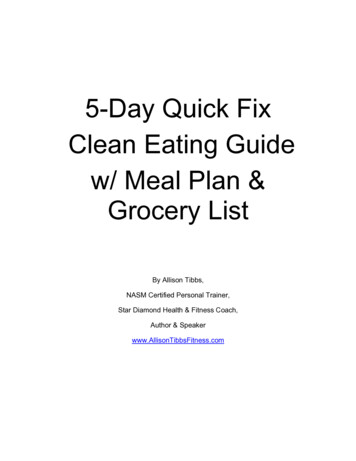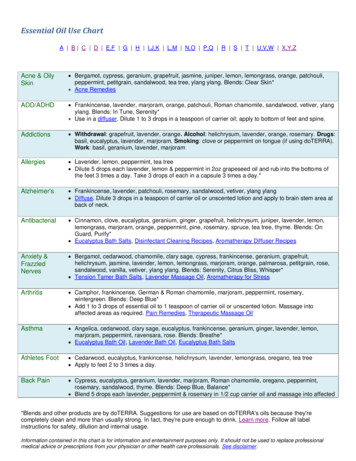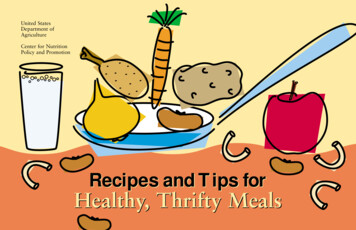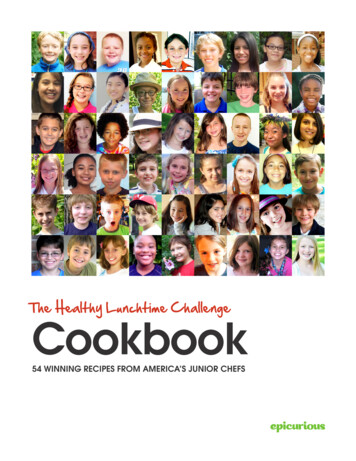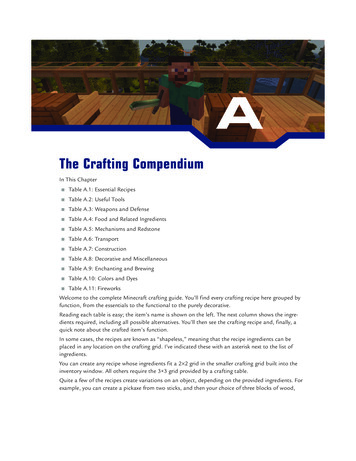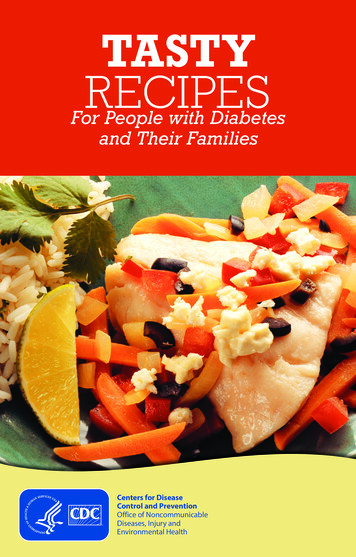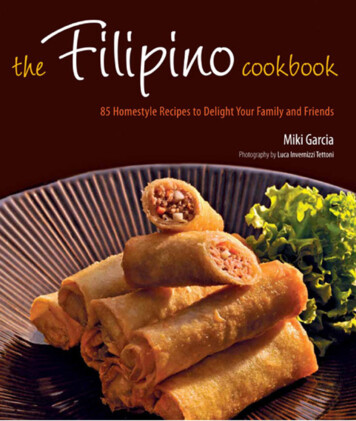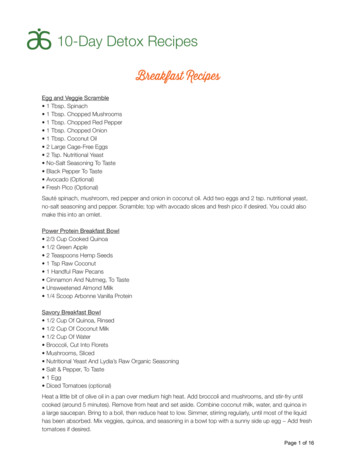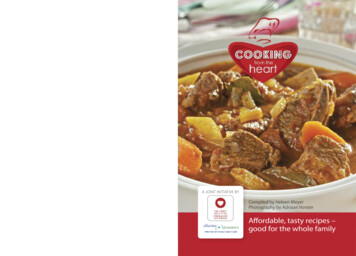
Transcription
A JOINT INITIATIVE BYCompiled by Heleen MeyerPhotography by Adriaan VorsterAffordable, tasty recipes –good for the whole family
ForewordContentsFood is central to the identity of South Africans.During meals the family meets around the table.On holidays and high days we gather around thebraai and the potjie pot which reflect the diversityof our country. Food has many memories associatedwith it – the soup that warms our bodies and oursouls, the dish for our homecomings, and therecipes that take us back to our youth.Food can also be our enemy. We are seeing rising levels of lifestyle diseasesin South Africa, with terrible impacts on our health – heart disease, stroke,type two diabetes and cancers are all on the rise, due to our increasinglypoor diet.We all know that staying healthy can be difficult. We have busy schedules,and shrinking household budgets. Healthy foods recommended to us oftenseem unavailable and unaffordable, leaving us feeling inadequate. It can betime-consuming to make the journey to the supermarket and to prepare ameal, when fast food is closer to home.Can we afford to spend more on so-called ‘healthy foods’? Do we have thetime to slave over a stove to make dishes that our families turn their nosesup at? The truth is healthy eating doesn’t have to be boring, expensive orcomplicated! It can be as simple as making small changes to your family’sfavourite dishes. This recipe book shows how to make food that tastesgood, is simple to prepare and is easy on the pocket. By using everydayingredients, you too can prevent yourself and your families from thedangers of different lifestyle diseases.I am passionate about making healthy living accessible to everyone inSouth Africa and increasing our understanding of the risk factors of seriousdiseases. It has so many implications for the future of our nation. This recipebook can show us how we can take responsibility for our own health, andhow to protect our families now and in the future.How healthily do you eat? .p2Guidelines for healthy eating .p4Planning healthy meals .p6Takeaways and eating out .p8Frequently asked questions .p10Shopping and cooking on a budget .p12Easy guide for reading food labels .p13Recipesw A bowl of soup .p14w Salads and veggies .p22w Lunch and supper .p34 Fish .p35 Vegetarian .p43 Chicken .p50 Meat .p60w Sweet treats and desserts .p70w Snacks, breads and baking .p82Everyday ingredients in your kitchen .p92Index .p93Something to remember:1 tbsp stands for 1 tablespoon 15 ml1 tsp stands for 1 teaspoon 5 ml½ tsp 2,5ml1 tsp 5 ml2 tsp 10 ml1 tbsp 15 ml2 tbsp 30 ml¼ cup 60 ml½ cup 125 ml1 cup 250 ml2 cups 500 mlwDesmond TutuThe recipes in this book wereselected from family favouritescontributed by people all overSouth Africa. These have beenadapted to follow the guidelines of the Heart and StrokeFoundation South Africa. Remember that healthy eating isimportant for the whole familyand not only for the personaffected by a lifestyle disease.Teach your children to eathealthily from a young age toprotect them from chronicdiseases later in life. Healthyfood doesn’t have to be expensive or bland and boring.We show you how to use aslittle fat, oil, salt and sugar aspossible and rather use herbs,lemon juice, salt-free spices andother seasonings to preparedelicious food. We want toencourage you and your familyto gradually make changes tothe way you eat and cook. Thiswill make a huge difference toyour health.
How healthily do you and your family eat?DO YOU USUALLY .?A healthy diet includes plenty of vegetables, fruit and high-fibrestarchy foods, and is low in fat (especially saturated fat), salt andsugar. Take the quiz on the next page to see how healthily you andyour family are eating. Your results will show whether you need toimprove your eating habits.POYES NOChoose wholewheat or brown bread and flour, rather than white bread orflour?Have at least 3 vegetables a day?Have at least 2 fresh fruit a day?If you ticked “No” for any of the questions, your and/or your family’sdiet can be improved. The more “No” answers you ticked, the moreunhealthy your diet is and the higher your risk of chronic diseasessuch as high blood pressure, diabetes, heart disease, stroke andcancer. You need to think about changing your diet to improve youroverall health. You can make a start by following the healthy eatingguidelines (pages 4-13) in this book and by preparing some of thedelicious recipes.Choose fat-free or low-fat dairy like milk, maas or yoghurt?Eat red meat (like mutton, beef or boerewors) less than 3 times a week?Include dried or tinned beans, split peas, lentils or soya in your meals at leasttwice a week?Remove all the visible fat from meat before you eat it?Remove the skin from chicken before cooking it?Avoid eating high-fat foods such as chips, viennas, polony or chocolate?Eat fish at least twice a week?Avoid eating takeaways or street foods like doughnuts, pies, vetkoek,samoosas, fried chips, fried chicken, gatsbies or ‘kotas’?Try to cook with less oil and avoid deep-frying foods?Avoid salty foods like polony, bacon, viennas, crisps, salty biscuits and highsalt sauces like soya or barbeque sauce?If you ticked “Yes” for some questions, you are making goodprogress, but you can still benefit by making more changes to youreating habits.If you ticked “Yes” every time – well done! You are well on your wayto preventing chronic diseases because you are choosing healthieroptions and avoiding the unhealthy foods eaten by many SouthAfricans.Carry on reading to learn more about healthy eating and why it isimportant for you and your family Avoid adding extra salt to your food at the table?Try to avoid adding high-salt ingredients like soup powders, stock cubes orsalty seasonings to your food?Choose healthier snacks like fruit, vegetables, low-fat or fat-free yoghurtbetween your meals?Use soft tub margarine for your bread, rather than butter or brick margarine?Avoid drinking sugary cold drinks or juices?2.Cooking from the heartHealthy eating questionnaire adapted from Love my body love myself, Dr Marjanne Senekal, Cape Town, 2005.
Guidelines for healthy eatingA healthy lifestyle helps to prevent and control chronic diseasessuch as high blood pressure, diabetes, heart disease, stroke andcancer. Healthy eating is one of the most important things youcan do for a healthier life. Remember that you also need to exercise regularly and avoid smoking. The following tips will help youand your family to eat healthily.Enjoy a varietyof foods. Eatingdifferent types offood gives your body allthe nutrients it needs.The more colourful yourplate of food, the widerthe variety.1Eat driedbeans, splitpeas, lentils orsoya at least twice aweek. They are a goodsource of protein, low infat and high in fibre. Youcan replace meat insome meals with thesefoods.2Make highfibre starchyfoods part ofmost meals. Thesefoods can help you feelfuller for longer andlower your risk of developing obesity,34.Cooking from the heartheart disease and cancer. Good examples arebrown or wholewheatbread, coarse maize(mealie) meal, oats andbrown rice.Bad fats can increaseyour cholesterol andblock your blood vessels, which can lead toa stroke or heart attack.Try to include tinned orfresh fish as part of yourTry to eat 5diet at least twice avegetables and week. Good examplesfruit every day. are pilchards, snoek,Remember to eat vegsardines or tuna.etables and fruit fromthe different colourHave low-fatgroups (red, green, yelmilk, maas orlow and orange). Theyoghurt everyvitamins, minerals andday. Dairy products arefibre in these foods help an excellent source ofto protect you againstcalcium. This can helpchronic diseases.protect your bones andhelp prevent high bloodChicken, fish,pressure, diabetes, osmeat or eggsteoporosis and heartcan be eatendisease. Good optionsevery day. Choose lean are low-fat or fat-freeor lower fat options with dairy products and reless bad (saturated) fats. duced-fat cheeses.465Eat less salt andavoid foods highin salt. Eatingtoo much salt can raiseyour blood pressureand increase your riskof stroke, heartattack and cancer.Some salt in your dietcomes from salt addedat the table or duringcooking, but more thanhalf of the salt that youeat comes from processed foods. Examplesare stock cubes, souppowders, salty snackslike chips and processedmeats like polony.Ideally, you shouldn’thave more than 1 teaspoon of salt a day fromall sources. Gradually cutdown on adding salt toyour food and soon youwon’t notice the difference.7Eat less fat anduse the righttype of fats oroils. Eating too muchfat and fried food canmake you gain weightand raise your cholesterol. Limit the amountof fatty red meat, butter,hard margarine, cream,lard and ghee that youuse. Rather use good(unsaturated) fats likevegetable oils and softtub margarine in smallamounts. Nuts, seeds,peanut butter and avocados are also sources ofgood fats.8Eat less sugarand avoid foodor drinks highin sugar. Too muchsugar can also makeyou gain weight, whichincreases your risk of9chronic diseases. Sugarin your diet comes fromsugar added to hotdrinks, cereals and cooking. High amounts ofsugar are also found incakes, biscuits, doughnuts, sweets, chocolatesand sweetened colddrinks.Drink plenty ofclean, safewater everyday. You need about6-8 glasses of water aday. Most of this shouldcome from tap water,but can include drinkslike tea, coffee or dilutedfruit juice as well.10If you drinkalcohol, drinkin moderation.Women should not havemore than 1 drink a dayand men not more than2 drinks a day. One drinkis equal to a can of beer(340 ml) or a small glassof wine (120 ml) or a totof spirits (25 ml).Pregnant and breastfeeding women shouldnot drink any alcohol atall, as it is very dangerous for the baby.11Cooking from the heart5.
Planning healthy mealsHere are some suggestions to make your meal planning easier. Choose oneoption per meal and one mid-morning and mid-afternoon snack.Many South Africans are overweight or obese. One way toprevent this is to control theportion size of the food youeat. These tips may help you: Use a smaller plate and don’toverfill it. Dish up only once and avoidhaving a second helping. Eat slowly and chew yourfood properly. Don’t finish your kids’ leftovers. Gradually make your portionsizes smaller. Each recipe in this bookshows the number of peoplethat it serves. Use this to guideyour portion sizes.6.Cooking from the heartWholewheat or brown toast with boiled egg and soft tub margarine, thinly spreadCooked oats porridge with cinnamon and low-fat or fat-free milkLight mealWholewheat or brown bread with pilchards OR left-over lean chicken or meat withlettuce, tomato and soft tub margarine, thinly spreadBaked beans on wholewheat or brown toast and soft tub margarine, thinly spreadBrown or wholewheat bread thinly spread with soft tub margarine with mozzarellacheese OR low-fat or fat-free cottage cheese OR boiled egg with lettuce and tomatoRotis (p83) with left-over vegetable curryHearty bean soup (p20) with wholewheat or brown toast and soft tub margarine, thinlyspreadChutney chicken (p56) with mashed potatoes (p32) and a green saladMain mealr portion sizeControlling youCoarse mealie meal or sorghum (mabella) porridge with low-fat or fat-free milk or maasSeasonal fresh fruit with low-fat or fat-free yoghurt sprinkled with raw oatsSpaghetti bolognese (p65) with salad or vegetablesFish cakes with pilchards (p41) with baked potatoes, peas and carrotsBeef stew with vegetables (p67) on papSpicy samp and beans (p48)Fresh fruit OR a small handful of dried fruitLow-fat or fat-free yoghurt OR low-fat maasSnacksPlanning your meals can help you eat more healthily within yourbudget. The food you eat should ideally be divided into 3 smallmixed meals a day, with healthy snacks in between. The advice andguidelines on the next page will help you plan effectively. Remember not to skip meals as it will make you feel hungry and maytempt you into eating unhealthy junk food, or eating toomuch at one time.BreakfastWholewheat or brown toast with peanut butter and bananaUnsalted peanuts OR unsalted mopani worms OR homemade unsalted popcorn(not pre-packaged) with no added butterRaw vegetable sticks like cucumber, carrots, celery or broccoli dipped in low-fat orfat-free cottage cheese or yoghurt OR roasted or boiled mealies (corn on the cob)Slice of wholewheat or brown bread with peanut butter OR pilchards OR lentil spreadOR avocado (when in season)Note – these ideas serve as a guide. For specific conditions such as diabetes,high cholesterol, hypertension or for weight loss, an individualised meal plan andportion guide is recommended. A dietitian could help you with more informationif you have one of these conditions.
Here are some good ideas on how to make healthier choices when eating outor when buying fast food from the cafeteria, street vendor or tuck shop.Takeaways and eating outEating out can still be part of a healthier lifestyle if you choose yourmeals carefully. Remember that many takeaway and restaurantmeals can be loaded with hidden fat, salt or sugar and the portions are often far too big.A few tips to remember: Choose restaurants,shebeens or takeaways thatprovide healthier options andnot just deep-fried foods. Lookout for menu items with theHeart Mark logo. Beware of ‘eat as much asyou like’ offers as this oftenmakes you eat too much andbecome overweight. Choose salads and veggieson the side instead of chips. Eat half of your meal andkeep some for lunch the nextday. Rather pack your own lunchbox to take to work or school.This is cheaper and will help youavoid buying fast or street foods.8.Cooking from the heartINSTEAD OF RATHER CHOOSE Fried foods Fried, battered, crumbed, deep-friedHealthier cooked foods Grilled, baked, roasted, steamed, boiledBig portions Large, giant, mega, super-sized, jumboSmaller portions Small, half, ladies, kiddies Order starter instead of main meal or sharemain mealGreasy breakfasts Fried or scrambled egg, bacon, sausages,chips Omelette with meat and cheese fillings Pastries, croissants, white toast, chocolateor sweet muffinsHealthier breakfasts Poached or boiled egg with grilled tomatoand mushrooms Omelette with veggie fillings Brown or wholewheat toast, muesli, fruitsalad, low-fat or fat-free yoghurtFatty main meals Fried fish, calamari, fish cakes, chicken,schnitzels or ribs, fatty cuts of steak Large pizza with thick base, lots of cheeseand meat toppingsLeaner main meals Grilled fish, chicken breasts or lean steak Small pizza with a thin base, half thecheese and more veggie toppingsSide dishes high in fat Fried chips, potato with sour cream, friedriceHealthier side dishes Steamed veggies, salad, baked potato(plain or with cottage cheese), steamed riceCream-based sauces Sauces made with cream, butter, cheeseLower fat sauces without cream or butter Tomato-based sauce, chilli sauce. Ordersauces on the side, so you can control howmuch you useSalads loaded with fats Creamy dressings, mayonnaise or toppingslike bacon, fried croutons, high-fat cheesesHealthier salads Salads with a variety of fresh veggies, lowfat dressings on the side, used sparinglyOily lunches Fried hamburgers with creamy sauces andchips Vetkoek, gatsbies or ‘kotas’ with processedmeats (viennas, polonies, russians, boerewors, salami), pies, samoosas, chilli bitesHealthier lunches Grilled chicken or pure beef burger with asalad or chicken or veggie wrap Brown, seeded or wholewheat bread orpita with a lean filling (lean ham, beef orchicken, tuna, pilchards, low-fat or fat-freecottage cheese) and green saladSugary drinks Sweetened fizzy cold drinks, energy drinks,juices with added sugar, milkshakes Sweet wine, sherry, spirits with sweetenedcold drinks, beers, ciders, spirit coolersSmarter drinks Water, sugar-free cold drinks, 100 % purefruit juices (preferably diluted with water),low-fat yoghurt drinks, rooibos tea Dry wine, spirits with water, soda water ordiet cold drinks, light beersRich desserts Creamy cakes, tarts, doughnuts, ice cream,creamy mousses, chocolate, creamSlimmer desserts Fruit salad, frozen low-fat yoghurt orsorbet, baked fruit
Frequently asked questions about healthy cookingCooking healthy meals is not as difficult as you may think. By makingsmall changes to the cooking methods and ingredients you use,your meals can be much lower in fat, salt and sugar.How can I cutdown on fatwhen cookingmeat for my family?1w Always remove thevisible fat from meat andthe skin from chicken.little water instead offrying them in oil.w Cooking food on amedium to low temperature allows you to useless oil.w Use cooking spraysw Drain off visible fatfor grilling or stir-frying.when cooking. Spoonout and throw away anyleft-over fat in the pan.w A non-stick or goodquality stainless steelpan can also help you touse less oil.w Allow soups, stewsand mince dishes tocool down. Then spoonoff the fat on top andthrow it away.w When pan-frying orroasting meat, ratherbrush the meat with oilinstead of pouring lotsof oil in the pan.2Which cookingmethods useless fat or oil?w Grill, steam, micro-wave, slow-cook, bake,stir-fry or pan-fry withvery little oil, rather thandeep-frying food.w Braise onions in a10.Cooking from the heartDo you havesome ideas toget fussy eatersto eat more vegetables?w Introduce kids to avariety of vegetablesfrom a young age. Teachthem to enjoy the natural flavour of veggiesearly on, without addingfat, salt or sugar.w Season vegetableswith spices like cinnamon or nutmeg withpumpkin, instead ofbutter or sugar.3w Make vegetables funfor kids by preparingcolourful vegetableskewers, cutting veggiesinto different shapes orarranging them intofunny faces.w Add grated or mashed vegetables as a hidden ingredient to fishcakes, meat balls, mincedishes, muffins, rice,stews and soups.This will also make yourmeals go further, addflavour and fibre, and willhelp them eat enoughveggies in a day.How can Iprepare vegetables withoutlosing their goodness?w Only peel vegetableswhen necessary.w When cookingveggies try to use aslittle water as possibleand don’t overcookthem.w Don’t soak cut veggies in water, as thevitamins and mineralswill leak into the water.4Make your favourite recipes healthier by swopping some of these ingredients.INSTEAD OF USING RATHER CHOOSE Cream cheese, processed cheeses, cheesespread or high-fat cheese like CheddarLow-fat or fat-free cottage cheese, lower fatcheeses like mozzarellaFull-cream milk, maas or creamLow-fat or fat-free milk, maas, plain yoghurtor reduced-fat evaporated milkButter, hard or brick margarine, ghee, shortening or lardVegetable oil (like sunflower or canola oil) orsoft tub margarineOily sauces like mayonnaise and creamysalad dressingsReduced-fat sauces like low-fat mayonnaise,plain yoghurt, tomato-based sauces, lowerfat salad dressingsWhite flour, white bread, white breadcrumbsBrown or wholewheat flour, bread, breadcrumbs, brown rice. Lentils or beans addedto white rice also helps increase your fibreintakeFatty meat or mince, organ meats or offal(tripe, brains, trotters, chicken feet)Meat with very little fat, lean or extra leanmince, fish, skinless chicken, beans and lentils.Game, goat and ostrich meat are leanerchoicesProcessed meats like polony, viennas,salami, russians and boereworsLean, unprocessed cold meats. Make gooduse of your left-overs like fish, skinless roastchicken (p50) or lean meat for sandwichesFood canned in oil or brineFood canned in tomato sauce. If you use fishcanned in oil, drain off excess oil. Foodcanned in brine can be lightly rinsed withwater to get rid of the extra saltCreamy, buttery or sugary sauces with vegetablesMake a lower fat sauce using low-fat or fatfree milk and leave out the butter. Use just alittle sauce over veggies. Use herbs or spicesto flavour veggies or enjoy them rawStock cubes, soup powdersHomemade stock (p15), cornflour, cake flouror split lentils to thicken soups or stewsSalt, salty seasonings like braai salt, barbeque or chicken spiceFresh or dried herbs, lemon juice, greenpepper, onions, parsley, garlic, ginger, saltfree spices (like chilli powder, coriander,cumin, curry powder, masala, paprika,pepper, turmeric)
Shopping and cooking on a budget Make a shopping list: Planyour meals and shopping. If youshop when you are hungry, youmay buy unnecessary or unhealthy luxuries. Know the price: Get to knowthe average price of groceries orthe price per kilogram. Look outfor specials on the things youreally need. Buy in bulk and in season:Buy vegetables and fruit whenthey are in season, as these areusually cheaper. Buy more veggies if fruit is too expensive.Buying discounted bulk or combofood and sharing with friends orfamily can help save money. Buymore veggies rather than moreexpensive meat. Stick to affordable healthyfoods: It is unnecessary to buyolive oil – sunflower or canola oilare good choices. Choose low-fator fat-free milk – these often costthe same as full-cream milk. Skimmilk powder is cheaper andhealthier than coffee or teacreamers. Tinned fish often costsless than fresh fish or meat and isjust as nutritious. Oats, sorghum(mabella) or coarse mealie porridge are healthier and cheaperthan some breakfast cereals. Do it yourself: Buy a wholechicken, cut into portions and remove the skin. Grate cheese orcut up veggies at home ratherthan buying expensive convenience food and meals.12.Cooking from the heartEasy guide for reading food labelsabled more afford lenariehltaehIfilabot always avaoptions are nethop, askat your local sh them andckostme.manager tors to do the saethoegraucoen Cook with the right sizepot: Try to use a pot or panthat is the same size as thestove plate or gas hob, to prevent wasting electricity or gas. Cook with a lid: Whenmaking a stew or soup, keepthe lid on. This way the foodcooks faster and less electricityis used. Cook for more than onemeal at a time: This saves youtime and electricity. Be creative with left-overs and usethem for lunches or to preparea second meal. Make your meals gofurther: Adding beans, lentilsor vegetables to bulk up meator mince dishes can makeyour meals healthier and moreaffordable. Think about your cooking options: Use the stovetop or microwave instead ofthe oven to save electricity.Hay or wonder boxes are veryeffective for slow-cookingbeans, lentils, rice or stews asthey do not use electricity.Reading food labels helps you make healthierchoices. You’ll soon learn which foods are better choices. There are a few things you needto look out for on labels when shopping.Ingredients listThe first few ingredientslisted on a label makesup the largest portion ofthe food. Thereforeavoid or eat less of afood if the followingwords are listed in thefirst few ingredients.OFat, oil, lard, butter,cream, shortening, transfat (or partially hydrogenated fats).OSalt or any wordwith ‘sodium’, MSG, nitrates or nitrites.OSugar, sucrose,glucose, maltose,dextrose, cane sugar,corn syrup, fructose.NutrientLow(values are per Go ahead!100 g of food) Eat more oftenNutritionalInformation table This shows you howmuch of each nutrient isin the food. Look at the numbersper 100 g of the productto compare similarfoods with each other. Use the table belowto decide if the food ishigh or low in fat, saturated fat, sugar andsodium (salt). Foods in the ‘low’group can be eatenmore often, but foods inthe ‘high’ group shouldbe eaten seldom or onspecial occasions.ModerateHighWatch out!Eat sometimesToo much!AvoidFatLess than 3 g3 g - 20 gMore than 20 gSaturated fatLess than 1.5 g1.5 g - 5 gMore than 5 gSugarLess than 5 g5 g - 15 gMore than 15 gSodium (salt)Less than 120 mg120 mg - 600 mgMore than 600 mgChoose food withthese logos. Healthorganisations have logoswhich they award tofoods that are healthierchoices. If you includethese foods as part of ahealthy diet, they canhelp prevent heart disease, cancer or diabetes.Cooking from the heart13.
A bowl of soupA bowl of soupHomemadechicken stockA steaming bowl of soup is a wholesome way tofeed a family. There is a soup for everyone – froma chicken and corn soup to a hearty bean soup.Flavour your soups with herbs and spices insteadof salty ingredients like stock cubes.Recipe from ThabisaDingiswayoMakes about 1 litre15. Homemade chicken stock16. Chicken and corn soup17. Vegetable soup with mince18. Mushroom soup19. Butternut soup20. Hearty bean soup21. Spicy red lentil and vegetable soupThis tasty stock can be usedto flavour soups, stews orany other dish that requiresstock. Shop-bought stocksare often very salty, so rathermake your own. It’s also agreat way to use the chickencarcasses that you wouldnormally throw away.1 cooked chicken carcassor bones from 4-6 portions1 large carrot, quartered1 large onion, quartered1 celery stalk with leaves,quartered6 cups (1,5 litres) water2 sprigs parsley2 bay leaves3 whole cloves5 black peppercorns1. Place all the ingredientsin a large pot.2. Bring to the boil, reducethe heat and simmer without a lid for 45 minutes todevelop the flavours.3. Pour the stock through asieve or spoon out veggies,herbs, spices and bones.4. Use stock according tothe recipe or cool completely and refrigerate for2-3 days. Alternatively,freeze and use instead ofbought stock.Tips1. Use fish heads ordouble the veggies tocook fish or vegetablestock.2. Add any other wholespices or add a slice offresh ginger, 2-3 clovesof garlic, a cinnamonstick or curry leaves formore flavour.Cooking from the heart15.
Vegetable soupwith minceA bowl of soupRecipe from Hettie LittleServes 8 – 101 tbsp (15 ml) sunflower oil250 g lean beef mince1 large onion, chopped1 clove of garlic, finelychopped1 tbsp (15 ml) paprika2 tsp (10 ml) groundcoriander1 tbsp (15 ml) dried mixedherbs1 tbsp (15 ml) WorcestersauceTipFish soup: Replace thechicken with left-overfish or hake. Stir intosoup at step 5.Chicken and cornsoupRecipe from Fazlin SandanServes 6 – 8This family recipe is a verypopular meal with both kidsand grown-ups.2 chicken breasts on thebone, skin and all fat removed1 tbsp (15 ml) sunflower oil2 onions, chopped1 clove of garlic, finelychopped2 large potatoes, peeledand chopped1 tsp (5 ml) ground cumin16.Cooking from the heart2 tsp (10 ml) groundcoriander4 cups (1 litre) water2 tbsp (30 ml) dried mixedherbs1 cup (250 ml) low-fat orfat-free milk1 cup (250 ml) frozenwhole kernel corn, rinsed(optional)1 x 410 g tin cream stylesweetcornlemon juice and blackpepper to taste3 tbsp (45 ml) choppedfresh coriander or parsley1. Cut chicken breasts inhalf with kitchen scissors ora sharp knife.2. Heat oil in a large potand fry chicken, onions andgarlic for a few minutes.3. Add potatoes, cumin,ground coriander, waterand dried herbs. Bring tothe boil, reduce the heatand simmer for 30 minutesor until the chicken iscooked.4. Spoon out the chicken.Remove bones and shredmeat.5. Stir chicken, milk, cornand sweetcorn into thesoup and heat through.6. Season with lemon juiceand pepper. Stir in freshherbs and serve.7. Remember that thetinned sweetcorn containssalt, so don’t add salt at thetable.Tips1. Enjoy left-overs forlunch the next day, orfreeze for another meal.2. Pea soup: Replacesoup mix with driedsplit peas.3. Stir in thinly shredded cabbage orspinach at the end ofthe cooking time.2 large tomatoes, peeledand chopped3 potatoes, peeled andcubed4 carrots, grated3 celery stalks with leaves,roughly chopped4 cups (1 litre) Homemadestock (p15) or water with2 tbsp dried mixed herbs8 cups (2 litres) water½ x 500 g packet driedsoup mix2 tsp (10 ml) sugar2 tsp (10 ml) garam masalalemon juice and blackpepper to taste1. Heat half the oil in a largepot and fry mince until golden brown. Spoon meat outand drain off any excess fat.2. Add rest of the oil and fryonion and garlic in thesame pot with paprika, coriander and herbs.3. Add mince and Worcestersauce and simmer for 10minutes. Add remaining ingredients, except the garammasala, lemon juice andpepper. Stir well.4. Simmer, with a lid, over alow heat for about 2 hoursor until the soup mix iscooked and the soup isthick. Stir every now andthen.5. Add the remaining ingredients and serve warm.
A bowl of soupMushroom soupRecipe from Mariam JaffarServes 4Mariam says that her recipehas been in the family foryears and is perfect for aspecial occasion. The homemade stock is delicious andcontains no added salt.1 tbsp (15 ml) sunflower oil1 large onion, chopped1 clove of garlic, finelychopped500 g mushrooms, sliced½ tsp (2,5 ml) curry powder or to taste¼ cup (60 ml) cake flour4 cups (1 litre) Homemadestock (p15) or water with2 tbsp dried mixed herbs1 cup (250 ml) low-fat orfat-free milklemon juice and blackpepper to taste2 tbsp (30 ml) choppedfresh parsley or thyme1. Heat oil in a large pot andfry onion and garlic for afew minutes.2. Add mushrooms andcurry powder and fry untilgolden brown.3. Stir in the flour until wellblended.4. Add stock and bring tothe boil. Reduce heat andsimmer for 20 minutes, oruntil slightly thickened.5. Stir in the milk. Seasonwith lemon juice and pepper and stir in parsley.6. Serve soup on its own orwith 1-2 slices of brown orwholewheat bread perperson as a main meal.18.Cooking from the heartolwetsiKomane RamButternut soupRecipe from KomaneRamolwetsiServes 6The spices and apple adddelicious flavours to thesoup and the potatoes giveit a creamy texture.Tips1. If you prefer, this soupcan be blended or liquidised.2. Broccoli soup: Replace the mushroomswith broccoli and simmer until the broccoli istender, but still brightgreen in colour. Serve asabove.3. Budget tip: Substitutehalf of the mushroomswith 2-3 potatoes,peeled and chopped.1 large (1 kg) butternut,peeled and chopped2 large potatoes, peeledand chopped2 onions, chopped1 Granny Smith apple,chopped2 tsp (10 ml) ground nutmeg1 tbsp (15 ml) groundcumin7 cups (1,75 litres) boilingwater½ cup (125 ml) low-fat orfat-free milklemon juice and blackpepper to taste1. Place veggies, apple andspices in a large pot withthe water.2. Bring to the boil, reducethe heat and simmer for 30minutes or until
Cooking from the heart Cooking from the heart 5. Guidelines for healthy eating A healthy lifestyle helps to prevent and control chronic diseases such as high blood pressure, diabetes, heart disease, stroke and cancer. Healthy eating is one of the most important things you can do f
